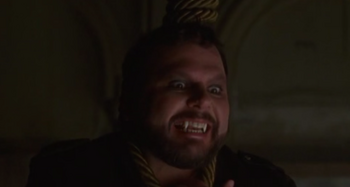m (Restored original spellling. This wiki is not U.S.English language centric. British English spelling is acceptable.) |
m (Unsourced material. ~ Admin) |
||
| Line 18: | Line 18: | ||
Vampires are mythical beings who subsist by feeding on the life essence (generally in the form of blood) of living creatures. In folkloric tales, undead vampires often visited loved ones and caused mischief or deaths in the neighbourhoods they inhabited when they were alive. They were markedly different from the gaunt, pale vampire which dates from the early 1800s. Although vampiric entities have been recorded in most cultures, the term vampire was not popularized until the early 18th century, after an influx of vampire superstition into Western Europe from areas where vampire legends were frequent, such as the Balkans and Eastern Europe. It is Bram Stoker's 1897 novel "Dracula" which is remembered as the quintessential vampire novel and provided the basis of the modern vampire legend.<ref>[[Wikipedia:Vampire]]</ref> |
Vampires are mythical beings who subsist by feeding on the life essence (generally in the form of blood) of living creatures. In folkloric tales, undead vampires often visited loved ones and caused mischief or deaths in the neighbourhoods they inhabited when they were alive. They were markedly different from the gaunt, pale vampire which dates from the early 1800s. Although vampiric entities have been recorded in most cultures, the term vampire was not popularized until the early 18th century, after an influx of vampire superstition into Western Europe from areas where vampire legends were frequent, such as the Balkans and Eastern Europe. It is Bram Stoker's 1897 novel "Dracula" which is remembered as the quintessential vampire novel and provided the basis of the modern vampire legend.<ref>[[Wikipedia:Vampire]]</ref> |
||
| − | |||
| − | The actual Vampire lore began with "THE VAMPYRE" which is a short work of prose fiction |
||
| − | |||
| − | written in 1816 by John William Polidori. "NOT BRAM STOKER" As it says above. |
||
| − | |||
| − | It began as part of a contest between Polidori, Mary Shelley, Lord Byron, and Percy Shelley. Byron started it out of boredom when they were all stranded at Villa Diodoti at Lake Geneva after weeks of torrential rain, gale force winds and powerful thunder & lightning. |
||
| − | <nowiki> </nowiki>Byron allegedly said "I Hear Witches in the Wind", and the contest began. |
||
| − | |||
| − | Mary Shelley's sister Claire Clairmont (pregnant with Byron's daughter Allegra at the time, was also there. The same event produced the novel FRANKENSTEIN.[1] The Vampyre is often viewed as the progenitor of the romantic vampire genre of fantasy fiction.[2] The work is described by Christopher Frayling as "the first story successfully to fuse the disparate elements of vampirism into a coherent literary genre."[3] |
||
[[Category:Season 1]] |
[[Category:Season 1]] |
||
[[Category:Characters]] |
[[Category:Characters]] |
||
Revision as of 08:07, 26 May 2019

Siegfried, a Vampire
A Vampire is a Dark Fae who feeds off human blood.
Character arc
The only vampire seen in the series has been Siegfried. Vex tortured and killed him for selling Dark Fae secrets.
Siegfried appeared to have enhanced strength. However, judging by the fact that Bo grabbed Siegfried by the throat and he seemed afraid of her, he was apparently not much stronger than her. He also seemed to have a heightened resistance to injury: Bo found him hanging from a noose from the ceiling, but when she approached him he simply awoke and lifted himself out, showing that the noose had not hurt him.
Unlike stereotypical vampires, Siegfried was seen in the sunlight inside his apartment and did not seem to be harmed by it.
In Lost Girl: The Game

Vampire icon
Trivia
Vampires are mythical beings who subsist by feeding on the life essence (generally in the form of blood) of living creatures. In folkloric tales, undead vampires often visited loved ones and caused mischief or deaths in the neighbourhoods they inhabited when they were alive. They were markedly different from the gaunt, pale vampire which dates from the early 1800s. Although vampiric entities have been recorded in most cultures, the term vampire was not popularized until the early 18th century, after an influx of vampire superstition into Western Europe from areas where vampire legends were frequent, such as the Balkans and Eastern Europe. It is Bram Stoker's 1897 novel "Dracula" which is remembered as the quintessential vampire novel and provided the basis of the modern vampire legend.[1]
